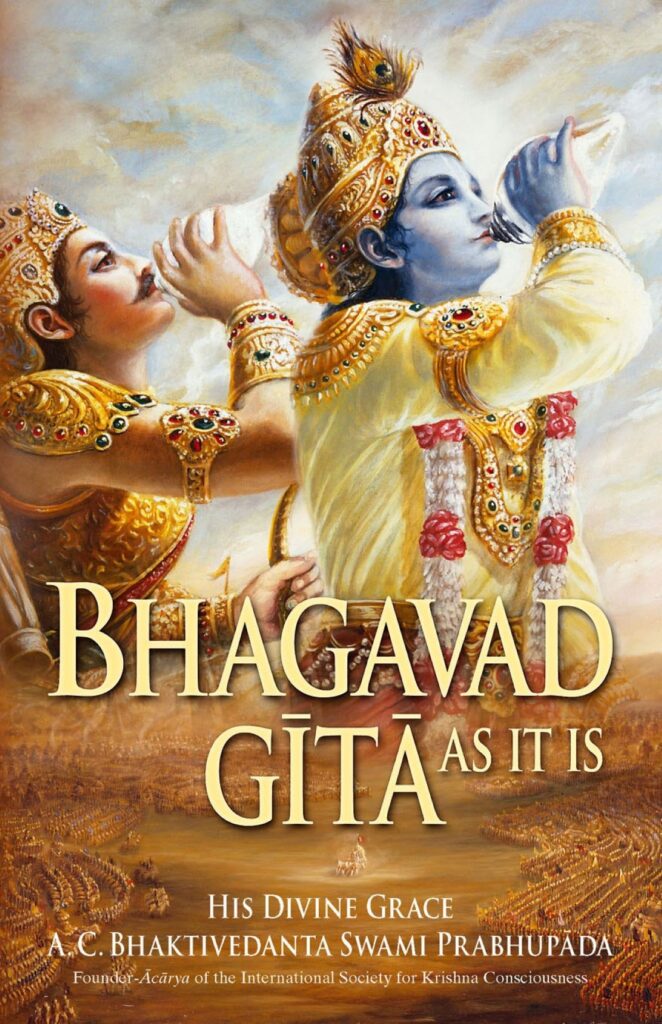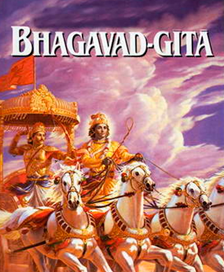Bhagavad-gita As It Is

Contents
Critics Praise Bhagavad-gita As It Is
Setting the Scene
Preface
Introduction
The Disciplic Succession
Chapter I, Observing the Armies on the Battlefield of Kuruksetra
Chapter II, Contents of the Gita Summarized
Chapter III, Karma-yoga
Chapter IV, Transcendental Knowledge
Chapter V, Karma-yoga – Action in Kṛṣṇa Consciousness
Chapter VI, Dhyana-yoga
Chapter VII, Knowledge of the Absolute
Chapter VIII, Attaining the Supreme
Chapter IX, The Most Confidential Knowledge
Chapter X, The Opulence of the Absolute
Chapter XI, The Universal Form
Chapter XII, Devotional Service
Chapter XIII, Nature, the Enjoyer, and Consciousness
Chapter XIV, The Three Modes Of Material Nature
Chapter XV, The Yoga of the Supreme Person
Chapter XVI, The Divine And Demoniac Natures
Chapter XVII, The Divisions of Faith
Chapter XVIII, Conclusion – The Perfection of Renunciation
Appendixes
A Note About the Second Edition
The Author
References
Glossary
Sanskrit Pronunciation Guide
Index of Sanskrit Verses
Index of Verses Quoted
Critics Praise Bhagavad-gītā As It Is
With over ten million hardbound copies in print in over fifty languages, Bhagavad-gītā As It Is, by His Divine Grace A. C. Bhaktivedanta Swami Prabhupāda, is the best-selling and most authoritative edition of this classic of world literature. Here are some comments on Bhagavad-gītā As It Is from some of the world’s leading scholars.
“There is little question that this edition is one of the best books available on the Gītā and on devotion. Prabhupāda’s translation is an ideal blend of literal accuracy and religious insight.”
Dr. Thomas J. Hopkins, Emeritus Chairman, Dept. of Religious Studies, Franklin and Marshall College
“The Gītā can be seen as the main literary support for the great religious civilization of India, the oldest surviving culture in the world. The present translation and commentary is another manifestation of the permanent living importance of the Gītā. Swami Bhaktivedanta brings to the West a salutary reminder that our highly activistic and one-sided culture is faced with a crisis that may end in self-destruction because it lacks the inner depth of an authentic metaphysical consciousness. Without such depth, our moral and political protestations are just so much verbiage.”
Thomas Merton, Catholic theologian, monk, author
“No work in all Indian literature is more quoted, because none is better loved in the West than Bhagavad-gītā. Translation of such a work demands not only knowledge of Sanskrit but an inward sympathy with the theme and a verbal artistry. For the poem is a symphony in which God is seen in all things.
“His Divine Grace A. C. Bhaktivedanta Swami Prabhupāda is, of course, profoundly sympathetic to the theme. He brings to it, moreover, a special interpretive insight, a powerful and persuasive presentation in the bhakti [devotional] tradition. . . . The Swami does a real service for students by investing the beloved Indian epic with fresh meaning. Whatever our outlook may be, we should all be grateful for the labor that has led to this illuminating work.”
Dr. Geddes MacGregor, Emeritus Distinguished Professor of Philosophy, University of Southern California
“In this beautiful translation, Śrīla Prabhupāda has caught the deep devotional spirit of the Gītā and has supplied the text with an elaborate commentary in the truly authentic tradition of Śrī Kṛṣṇa Caitanya, one of India’s most important and influential saints.”
Dr. J. Stillson Judah, Emeritus Professor of the History of Religions and Director of the Library, Graduate Theological Union, Berkeley
“If truth is what works, as Pierce and the pragmatists insist, there must be a kind of truth in the Bhagavad-gītā As It Is, since those who follow its teachings display a joyous serenity usually missing in the bleak and strident lives of contemporary people.”
Dr. Elwin H. Powell, Professor of Sociology, State University of New York
“Whether the reader be an adept of Indian spirituality or not, a reading of Bhagavad-gītā As It Is will be extremely profitable, for it will allow him to understand the Gītā as still today the majority of Hindus do. For many, this will be the first contact with the true India, the ancient India, the eternal India.”
Dr. Francois Chenique, Doctor of Religious Sciences, Institute of Political Studies, Paris
“Bhagavad-gītā As It Is is a deeply felt, powerfully conceived and beautifully explained work. . . . I have never seen any other work on the Gītā with such an important voice and style. It is a work of undoubted integrity. . . . It will occupy a significant place in the intellectual and ethical life of modern man for a long time to come.”
Dr. S. Shukla, Assistant Professor of Linguistics, Georgetown University
गीतोपनिषद्
As It Is
translation and elaborate purports
A. C. Bhaktivedanta Swami Prabhupāda
Acārya of the International Society for Krishna Consciousness
Books by His Divine Grace
A. C. Bhaktivedanta Swami Prabhupāda
Books compiled from the teachings
of Śrīla Prabhupāda after his lifetim
To
Śrīla Baladeva Vidyābhūṣaṇa,
who presented so nicely
the Govinda-bhāṣya commentary
on Vedānta philosophy
Setting the Scene
Although widely published and read by itself, Bhagavad-gītā originally appears as an episode in the Mahābhārata, the epic Sanskrit history of the ancient world. The Mahābhārata tells of events leading up to the present Age of Kali. It was at the beginning of this age, some fifty centuries ago, that Lord Kṛṣṇa spoke Bhagavad-gītā to His friend and devotee Arjuna.
Their discourse – one of the greatest philosophical and religious dialogues known to man – took place just before the onset of war, a great fratricidal conflict between the hundred sons of Dhṛtarāṣṭra and on the opposing side their cousins the Pāṇḍavas, or sons of Pāṇḍu.
Dhṛtarāṣṭra and Pāṇḍu were brothers born in the Kuru dynasty, descending from King Bharata, a former ruler of the earth, from whom the name Mahābhārata derives. Because Dhṛtarāṣṭra, the elder brother, was born blind, the throne that otherwise would have been his was passed down to the younger brother, Pāṇḍu.
When Pāṇḍu died at an early age, his five children – Yudhiṣṭhira, Bhīma, Arjuna, Nakula and Sahadeva – came under the care of Dhṛtarāṣṭra, who in effect became, for the time being, the king. Thus the sons of Dhṛtarāṣṭra and those of Pāṇḍu grew up in the same royal household. Both were trained in the military arts by the expert Droṇa and counseled by the revered “grandfather” of the clan, Bhīṣma.
Yet the sons of Dhṛtarāṣṭra, especially the eldest, Duryodhana, hated and envied the Pāṇḍavas. And the blind and weak-minded Dhṛtarāṣṭra wanted his own sons, not those of Pāṇḍu, to inherit the kingdom.
Thus Duryodhana, with Dhṛtarāṣṭra’s consent, plotted to kill the young sons of Pāṇḍu, and it was only by the careful protection of their uncle Vidura and their cousin Lord Kṛṣṇa that the Pāṇḍavas escaped the many attempts against their lives.
Now, Lord Kṛṣṇa was not an ordinary man but the Supreme Godhead Himself, who had descended to earth and was playing the role of a prince in a contemporary dynasty. In this role He was also the nephew of Pāṇḍu’s wife Kuntī, or Pṛthā, the mother of the Pāṇḍavas. So both as a relative and as the eternal upholder of religion, Kṛṣṇa favored the righteous sons of Pāṇḍu and protected them.
Ultimately, however, the clever Duryodhana challenged the Pāṇḍavas to a gambling match. In the course of that fateful tournament, Duryodhana and his brothers took possession of Draupadī, the chaste and devoted wife of the Pāṇḍavas, and insultingly tried to strip her naked before the entire assembly of princes and kings. Kṛṣṇa’s divine intervention saved her, but the gambling, which was rigged, cheated the Pāṇḍavas of their kingdom and forced them into thirteen years of exile.
Upon returning from exile, the Pāṇḍavas rightfully requested their kingdom from Duryodhana, who bluntly refused to yield it. Duty-bound as princes to serve in public administration, the five Pāṇḍavas reduced their request to a mere five villages. But Duryodhana arrogantly replied that he wouldn’t spare them enough land into which to drive a pin.
Throughout all this, the Pāṇḍavas had been consistently tolerant and forbearing. But now war seemed inevitable.
Nonetheless, as the princes of the world divided, some siding with the sons of Dhṛtarāṣṭra, others with the Pāṇḍavas, Kṛṣṇa Himself took the role of messenger for the sons of Pāṇḍu and went to the court of Dhṛtarāṣṭra to plead for peace. When His pleas were refused, war was now certain.
The Pāṇḍavas, men of the highest moral stature, recognized Kṛṣṇa to be the Supreme Personality of Godhead, whereas the impious sons of Dhṛtarāṣṭra did not. Yet Kṛṣṇa offered to enter the war according to the desire of the antagonists. As God, He would not personally fight; but whoever so desired might avail himself of Kṛṣṇa’s army – and the other side could have Kṛṣṇa Himself, as an advisor and helper. Duryodhana, the political genius, snatched at Kṛṣṇa’s armed forces, while the Pāṇḍavas were equally eager to have Kṛṣṇa Himself.
In this way, Kṛṣṇa became the charioteer of Arjuna, taking it upon Himself to drive the fabled bowman’s chariot. This brings us to the point at which Bhagavad-gītā begins, with the two armies arrayed, ready for combat, and Dhṛtarāṣṭra anxiously inquiring of his secretary Sañjaya, “What did they do?”
The scene is set, with only the need for a brief note regarding this translation and commentary.
The general pattern translators have followed in rendering Bhagavad-gītā into English has been to brush aside the person Kṛṣṇa to make room for their own concepts and philosophies. The history of the Mahābhārata is taken as quaint mythology, and Kṛṣṇa becomes a poetic device for presenting the ideas of some anonymous genius, or at best He becomes a minor historical personage.
But the person Kṛṣṇa is both the goal and the substance of Bhagavad-gītā, so far as the Gītā speaks of itself.
This translation, then, and the commentary that accompanies it propose to direct the reader to Kṛṣṇa rather than away from Him. The Bhagavad-gītā thus becomes wholly consistent and comprehensible. Since Kṛṣṇa is the speaker of the Gītā, and its ultimate goal as well, the Bhagavad-gītā As It Is presents this great scripture in its true
